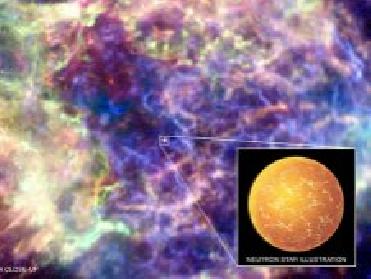
Central region of the supernova remnant Cassiopeia A. Image credit: NASA
WASHINGTON (BNS): Cracking a decade-long mystery surrounding a supernova remnant, NASA’s Chandra X-ray Observatory has detected a thin veil of carbon on a neutron star located at the centre of the supernova.
“The compact star at the centre of this famous supernova remnant has been an enigma since its discovery. Now we finally understand that it can be produced by a hot neutron star with a carbon atmosphere,” said Wynn Ho of the University of Southampton and lead author of a paper that appears in the latest issue of Nature.
By analysing Chandra's X-ray spectrum and applying it to theoretical models, Ho and his colleague Craig Heinke, from the University of Alberta, have found that the neutron star in Cassiopeia A (Cas A) supernova remnant has an ultra-thin coating of carbon.
This is the first time the atmospheric composition of an isolated neutron star has been confirmed, NASA said.
The Chandra “First Light” image of Cas A in 1999 had revealed a previously undetected point-like source of X-rays at the centre. This object was presumed to be a neutron star – the typical remnant of an exploded star. But researchers were unable to understand its properties. Defying astronomers’ expectations, the object did not show any X-ray or radio pulsations or any signs of radio pulsar activity.
By applying a model of a neutron star with a carbon atmosphere to this object, Ho and Heinke found that the region emitting X-rays would uniformly cover a typical neutron star. This would explain the lack of X-ray pulsations because – like a light bulb that shines consistently in all directions – this neutron star would be unlikely to display any changes in its intensity as it rotates.
“Our carbon veil solves one of the big questions about the neutron star in Cas A,” said Craig Heinke.
Unlike other cosmic objects, the tiny neutron stars – typically having a diameter of about 22 km – are difficult to understand on a human scale. The atmosphere of a neutron star is on an even smaller scale. The researchers calculate that the carbon atmosphere is only about 4 inches thick, because it has been compressed by a surface gravity that is 100 billion times stronger than on Earth.
In Earth’s time frame, the estimated age of the neutron star in Cas A is only several hundred years, making it about ten times younger than other neutron stars with detected surface emission. Therefore, the Cas A neutron star gives a unique window into the early life of a cooling neutron star.
The carbon itself comes from a combination of material that has fallen back after the supernova, and nuclear reactions on the hot surface of the neutron star which convert hydrogen and helium into carbon.
The X-ray spectrum and lack of pulsar activity suggest that the magnetic field on the surface of this neutron star is relatively weak. Similarly low magnetic fields are implied for several other young neutron stars by study of their weak X-ray pulsations. It is not known whether these neutron stars will have low magnetic fields for their entire lives, and never become radio pulsars, or whether processes in their interior will lead to the development of stronger magnetic fields as they age.
 Previous Article
Previous Article













The Indian Air Force, in its flight trials evaluation report submitted before the Defence Ministry l..
view articleAn insight into the Medium Multi-Role Combat Aircraft competition...
view articleSky enthusiasts can now spot the International Space Station (ISS) commanded by Indian-American astr..
view article